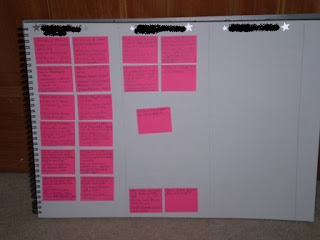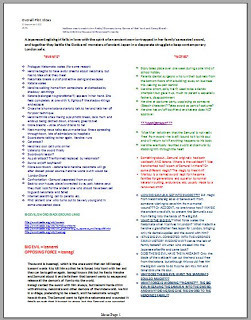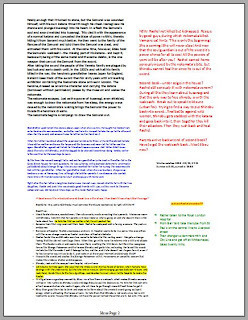PLOTTING A TRILOGY
You guys may have noticed that out of all the parts of a writer's process I could talk about, plotting is the one that comes up most often on this blog. Please don't run away with the idea that this is because I'm a plotting expert. I'm...seriously not. Plotting and pacing are the things I struggle with most and enjoy the least.
Characterisation? Comes pretty naturally, once I let my characters into my head. Style? I LOVE the English language, and I love playing with words and trying to create beautiful and startling images. But plot? God, just tie me into a hessian bag, wrap it in chains and throw it in a river. It'll be less painful and a heck of a lot less helpless feeling.
I've heard many other authors say that they love the planning stage of writing, when literally anything can happen, and they can play around with events, change anything they want, and not have to worry about it. I'm not sure what weird mojo goes on in those writer's heads, but it is entirely foreign to me, because frankly, when I first start trying to figure out what happens to who in a book and why and in what order, it feels as if I'm struggling around waist deep in a soup full of unexpected sharp/hard objects that keep hitting me and knocking me over. Blind folded.
That's why I'm always coming up with different ways to try and make plotting easier for myself (and you!). I've showed you my bullet-pointed lists and my diamond-diagrams before. Those serve me pretty well in a general way. But when I came to try and write the synopses for The Big Secret Project, which is a trilogy, I found that they just weren't helping me. I had so many more events to keep track of. I needed to be able to see not just the plot and character arcs for one book, but for three, and the over-arcing plot that would join all three stories together.
And so... I went out to my local stationary shop and grabbed some supplies. I decided I need a massive pad of paper so that I could see all my plots working against each other at the same time. Post-it notes also seemed like a good idea because that way I could try to imitate those 'I Love Planning' authors and move my events around easily. I needed a ruler to draw columns.

The coloured pens and star stickers were just for fun.
The first thing I did was to try and figure out what all the hard/sharp objects bumping into me in the soup were. I mean, maybe not all of them would be useful, but I wanted them out of the soup and on the page. So, I decided to brainstorm. I don't normally find brainstorming particularly helpful because it just makes me more confused (shut up, I can't HELP the way my brain IS, okay?) but in this case I assigned each book a colour and then randomly wrote down all the ideas I had for each one.

In some places I instantly realised that certain ideas fitted together better than others, and if they were marked the wrong colour, I put an asterisk in the right colour next to them. In other places I had cool ideas that didn't really seem anchored to the plot I had in mind and those got a star sticker. Looking at everyone all at once like that might seem like it would be overwhelming, but actually once it was on the paper it felt much more organised than it had in my head (not hard, really).
The second thing I did was to divide one page into three parts and start putting Post-its in lines so that I could see the stories for each book working parallel to one another. You will notice, by the way, in these pictures, that I have deliberately blurred out a lot of the words and the titles. This is because I know that certain readers, naming no names (*cough*Saya*cough*) would have no hesitation in zooming in and trying to make out details of The Big Secret Project. And since it's Secret, and all subject to change anyway, I just can't have that. Sorry! But I hope you can still see what I was aiming for.

Then I decided to break down the most important part of the story, which is the heroine's emotional arc, and how she changes throughout both books, what issues she has to start with, and when and how these are resolved.

With all this firmly pinned down I broke out the Microsoft OneNote programme, which I find particularly useful because it lets you scribble randomly all over the place, but keeps everything neat for you. I came up with this:


Which (one of the nice features of OneNote) includes links to useful webpages where I can go back and check my facts.
Having done all this, I now have a pretty good idea of what is going to happen to who, when and how. So I'm going to ask a question of my lovely blog readers, and your answer might influence the way this story is written.
My heroine needs to have a best friend. I know who this person is inside, but what I haven't decided yet is their outter trappings - ie, their gender and sexuality. It's always been really important for me to try and include characters of different cultures, races and faiths in my work, but recently I've also been attempting to include characters who do not fit into the Western World's narrow definition of heteronormative behavior. So help me out. What would make you happy? Do you think my heroine's best friend should be a gay GUY, or a gay GIRL? Either way they are extremely fierce, smart and protective, are a little bit Goth, and end up having an extremely complex love life throughout these books.
Tell me what you think in the comments!
Characterisation? Comes pretty naturally, once I let my characters into my head. Style? I LOVE the English language, and I love playing with words and trying to create beautiful and startling images. But plot? God, just tie me into a hessian bag, wrap it in chains and throw it in a river. It'll be less painful and a heck of a lot less helpless feeling.
I've heard many other authors say that they love the planning stage of writing, when literally anything can happen, and they can play around with events, change anything they want, and not have to worry about it. I'm not sure what weird mojo goes on in those writer's heads, but it is entirely foreign to me, because frankly, when I first start trying to figure out what happens to who in a book and why and in what order, it feels as if I'm struggling around waist deep in a soup full of unexpected sharp/hard objects that keep hitting me and knocking me over. Blind folded.
That's why I'm always coming up with different ways to try and make plotting easier for myself (and you!). I've showed you my bullet-pointed lists and my diamond-diagrams before. Those serve me pretty well in a general way. But when I came to try and write the synopses for The Big Secret Project, which is a trilogy, I found that they just weren't helping me. I had so many more events to keep track of. I needed to be able to see not just the plot and character arcs for one book, but for three, and the over-arcing plot that would join all three stories together.
And so... I went out to my local stationary shop and grabbed some supplies. I decided I need a massive pad of paper so that I could see all my plots working against each other at the same time. Post-it notes also seemed like a good idea because that way I could try to imitate those 'I Love Planning' authors and move my events around easily. I needed a ruler to draw columns.

The coloured pens and star stickers were just for fun.
The first thing I did was to try and figure out what all the hard/sharp objects bumping into me in the soup were. I mean, maybe not all of them would be useful, but I wanted them out of the soup and on the page. So, I decided to brainstorm. I don't normally find brainstorming particularly helpful because it just makes me more confused (shut up, I can't HELP the way my brain IS, okay?) but in this case I assigned each book a colour and then randomly wrote down all the ideas I had for each one.

In some places I instantly realised that certain ideas fitted together better than others, and if they were marked the wrong colour, I put an asterisk in the right colour next to them. In other places I had cool ideas that didn't really seem anchored to the plot I had in mind and those got a star sticker. Looking at everyone all at once like that might seem like it would be overwhelming, but actually once it was on the paper it felt much more organised than it had in my head (not hard, really).
The second thing I did was to divide one page into three parts and start putting Post-its in lines so that I could see the stories for each book working parallel to one another. You will notice, by the way, in these pictures, that I have deliberately blurred out a lot of the words and the titles. This is because I know that certain readers, naming no names (*cough*Saya*cough*) would have no hesitation in zooming in and trying to make out details of The Big Secret Project. And since it's Secret, and all subject to change anyway, I just can't have that. Sorry! But I hope you can still see what I was aiming for.

Then I decided to break down the most important part of the story, which is the heroine's emotional arc, and how she changes throughout both books, what issues she has to start with, and when and how these are resolved.

With all this firmly pinned down I broke out the Microsoft OneNote programme, which I find particularly useful because it lets you scribble randomly all over the place, but keeps everything neat for you. I came up with this:


Which (one of the nice features of OneNote) includes links to useful webpages where I can go back and check my facts.
Having done all this, I now have a pretty good idea of what is going to happen to who, when and how. So I'm going to ask a question of my lovely blog readers, and your answer might influence the way this story is written.
My heroine needs to have a best friend. I know who this person is inside, but what I haven't decided yet is their outter trappings - ie, their gender and sexuality. It's always been really important for me to try and include characters of different cultures, races and faiths in my work, but recently I've also been attempting to include characters who do not fit into the Western World's narrow definition of heteronormative behavior. So help me out. What would make you happy? Do you think my heroine's best friend should be a gay GUY, or a gay GIRL? Either way they are extremely fierce, smart and protective, are a little bit Goth, and end up having an extremely complex love life throughout these books.
Tell me what you think in the comments!
Published on December 13, 2010 09:46
No comments have been added yet.



